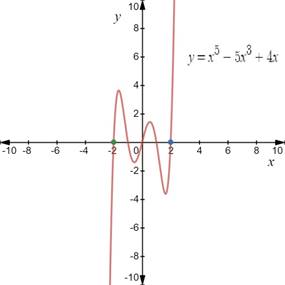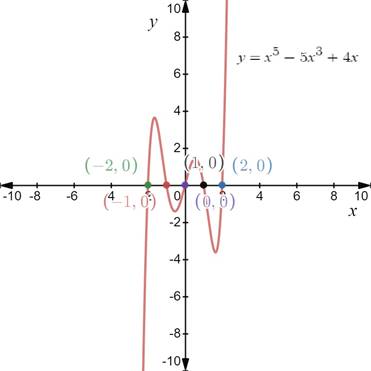
Concept explainers
a.
Finding zeros of a Polynomial function algebraically.
a.
Explanation of Solution
Given:
The equation is
Approach:
- Solve the Polynomial algebraically.
- Find the values of x.
Calculation:
Consider,
Putting the value of
Therefore, the real zeros of a polynomial function are
b.
Use a graphing utility to graph the function.
b.
Explanation of Solution
Given:
The equation is given as,
Approach:
- Draw the given equations on the graph.
Graph; The graph of the above equations are given below

Since the above graph intersect x-axis at many points.
Therefore, the polynomial has many zeros.
c.
Use the graph to compare them with those from part (a).
c.
Explanation of Solution
Given:
The equation is
Approach:
- Draw the given equations on the graph.
- Compare them with the part -a.
Graph:
The graph of the above equations are given below

This shows that the zeros of the polynomial are
While here, all the zeros were represented by the graph actually crossing through the x-axis.
Chapter 2 Solutions
PRECALCULUS W/LIMITS:GRAPH.APPROACH(HS)
- The boom OA carries a load P and is supported by two cables as shown. Knowing that the tension in cable AB is 190 lb and that the resultant of the load P and of the forces exerted at A by the two cables must be directed along OA, determine the tension in cable AC. 29 in. B 24 in. 36 in. C 25 in. 48 in.. Aarrow_forwardFind the distance (d) from the point (8, -7, -1) to the plane 3x+5y-3z = -60.arrow_forwardThe 60-lb collar A can slide on a frictionless vertical rod and is connected as shown to a 65-lb counterweight C. Draw the free-body diagram of the collar that is needed to determine the value of h for which the system is in equilibrium. -15 in. A 60 lb B C h 65 lbarrow_forward
- Two cables tied together at Care loaded as shown. Given: Q = 130 lb. 30° C B Determine the range of values of P for which both cables remain taut. lbarrow_forwardFind the parametric equation for the line where the planes -4x+y+3x= -11 and -2x+y=3z = 7 intersect.arrow_forwardDo the Laplace Transformation and give the answer in Partial Fractions. Also do the Inverted Laplace Transformation and explain step-by-step.arrow_forwardDo the Laplace Transformation and give the answer in Partial Fractions. Also do the Inverted Laplace Transformation and explain step-by-step.arrow_forwardDo the Laplace Transformation and give the answer in Partial Fractions. Also do the Inverted Laplace Transformation and explain step-by-step.arrow_forward纟 W₂ Find S-FX SB.MXarrow_forwardarrow_back_iosSEE MORE QUESTIONSarrow_forward_ios
 Calculus: Early TranscendentalsCalculusISBN:9781285741550Author:James StewartPublisher:Cengage Learning
Calculus: Early TranscendentalsCalculusISBN:9781285741550Author:James StewartPublisher:Cengage Learning Thomas' Calculus (14th Edition)CalculusISBN:9780134438986Author:Joel R. Hass, Christopher E. Heil, Maurice D. WeirPublisher:PEARSON
Thomas' Calculus (14th Edition)CalculusISBN:9780134438986Author:Joel R. Hass, Christopher E. Heil, Maurice D. WeirPublisher:PEARSON Calculus: Early Transcendentals (3rd Edition)CalculusISBN:9780134763644Author:William L. Briggs, Lyle Cochran, Bernard Gillett, Eric SchulzPublisher:PEARSON
Calculus: Early Transcendentals (3rd Edition)CalculusISBN:9780134763644Author:William L. Briggs, Lyle Cochran, Bernard Gillett, Eric SchulzPublisher:PEARSON Calculus: Early TranscendentalsCalculusISBN:9781319050740Author:Jon Rogawski, Colin Adams, Robert FranzosaPublisher:W. H. Freeman
Calculus: Early TranscendentalsCalculusISBN:9781319050740Author:Jon Rogawski, Colin Adams, Robert FranzosaPublisher:W. H. Freeman
 Calculus: Early Transcendental FunctionsCalculusISBN:9781337552516Author:Ron Larson, Bruce H. EdwardsPublisher:Cengage Learning
Calculus: Early Transcendental FunctionsCalculusISBN:9781337552516Author:Ron Larson, Bruce H. EdwardsPublisher:Cengage Learning





